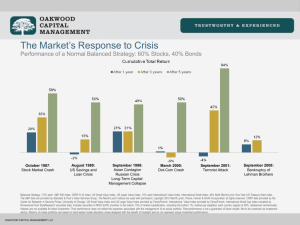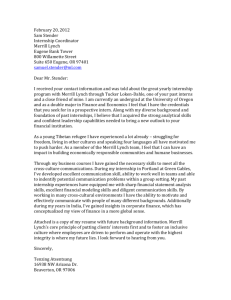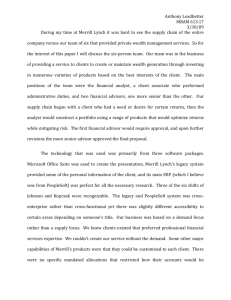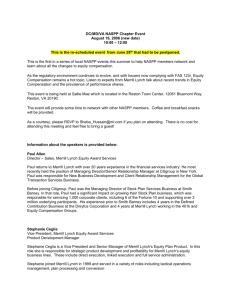Risks in 2012
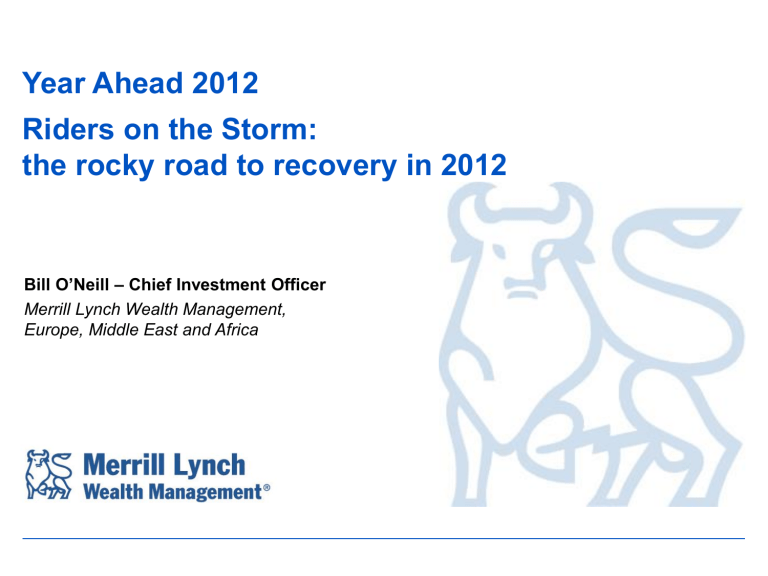
Year Ahead 2012
Riders on the Storm: the rocky road to recovery in 2012
Bill O’Neill – Chief Investment Officer
Merrill Lynch Wealth Management,
Europe, Middle East and Africa
Key points
CIO View – key points for 2012
Global growth and profits weaker in 2012
Deleveraging – the contraction of debt held- to persist as key influence in developed economies
Opposing this trend will be policy loosening or stimulus- its extent and timing are crucial
Quantitative easing (money printing) will become a global phenomenon
China will have a ‘soft landing’ in 2012 – again the key development is when policy eases
• Look for portfolio diversification , focus on a strategic framework to respond to the ‘New Normal’
Equity outperformance versus corporate debt will be modest
On equities, prefer U.S. and U.K. over Japan and Europe; stress theme of yield - quality - growth
Little value in core sovereign bonds
We shall see a weaker euro into 2012 especially if ECB buys government debt
Upside on gold above $2000 p/oz.
; oil price flat for first half, moving higher as demand improves
2
The pressing need for mature economies to contain debt burdens has taken us to the edge of a second global recession in less than
3 years
2011 asset class performance
%
Overview
Source: Bloomberg. Data as of 30 December 2011.
3
Eurozone sovereign crisis is also a banking crisis
Cost of protection for European banks and sovereigns
Basis points
400
European banks European sovereigns average*
300
Overview
200
100
0
2007 2008 2009 2010 2011
Source: Bloomberg. Data as of November 2011. *European sovereigns average is a simple average of French and Italian government debt credit default swaps
(CDS)
4
U.S. bonds following Japan’s example so far, only this time real rates likely to remain low
Japan and superimposed U.S. 10 year real bond yield, 13 years later (%)*
5
4
7
%
6
3 2000
2
1
0
-1
1987 1992
Japan
2011
1997
U.S. (start and end dates shown)
2002 2007
Overview
Source: Bloomberg. Data as of November 2011. *U.S .10-year bond yield superimposed over Japan, with a lead . U.S. data from November 2000 to November 2011
5
The U.S. recovery in the ‘New Normal’ is very subdued compared to history
Economics
The Zarnowitz Law, looking at strength of recovery against peak-to trough fall in business cycle
8 quarter gain from recession trough (%)
16%
14%
12%
10%
8%
6%
4%
2%
0%
0%
2001
1970
-1%
1960
1990
1980
1981
1953 1973
1957 2008 - where we
should have been
8.7% difference
2008 - where we were
-5% -6% -2% -3%
Loss from peak - to - trough (%)
-4%
Source: Bureau of Economic Research, National Bureau of Economic Research, TrendMacro calculations. Data as of September 2011.
6
Reluctance of businesses to invest risks persistently higher structural unemployment
U.S. average number of weeks unemployed and business investment as % of GDP
Economics
% of GDP
% of total
The Federal Reserve will respond to high unemployment with direct support to housing . No rate hike until at least 2014
Source: Absolute Strategy Research, Bloomberg. Data as of November 2011.
7
Optimistic growth forecasts still mark the path to debt stabilisation in the eurozone
Differing expectations for real GDP growth rates in several eurozone nations in 2012
Economics
2
1
0
-1
-2
-3
-4
4
%
3
Government trend growth assumptions Bank of America Merrill Lynch 2012 forecast
Germany Ireland Greece France Italy
Source: Factset, Bloomberg, BofA Merrill Lynch Global Research. Data as at November 2011.
8
European debt deleveraging has a large banking component
Eurozone* and U.S. total debt to GDP as of Q1 2011**, with sectoral breakdown
Economics
Eurozone*
23
15
33
29
U.S.
24
21
28
27
Households Financial Non-financial General government Households Financial Non-financial General government
Source: BofA Merrill Lynch Rates and Currency Research. Created 15 December 2011. Data as at Q1 2011, except French household (2010).
*Eurozone countries = Germany, France, Italy, Spain, Greece, Portugal, Ireland, Belgium, Netherlands & Slovakia
** Latest data available given lack of data from Greece, inter alia, since start of 2011.
9
China’s next 5-year plan to focus on supporting consumption following 2009 fiscal expansion
Chinese exports, fixed asset investment and retail sales as a percentage of GDP
%
Policy
Source: Absolute Strategy Research. Data as of October 2011.
10
Policy
Debt reduction options
Solution
Growth
Explanation
Higher growth leads to lower government debt
Fiscal support weakens
Examples
South Korea
Fiscal Adjustment and Austerity
Governments adopt strict fiscal austerity
adopted alongside economic reform
Eurozone (especially periphery), U.K
., not the U.S.
Sovereign
Default/Debt
Restructuring
Governments write off their debts
A restructure involves an adjustment in the terms of existing debt
Default: Russia, Argentina , possibly Greece
Feasibility
High household/financial debt likely to weigh on activity
Unpopular with voters and correct spending/tax mix challenging
Would lead to inability to access capital markets for funding, adverse effects on banking sector
Currency
Devaluation
Devaluing the currency of issue makes debt easier to repay
Hungary, Finland, Iceland
U.S. QE2 (quantitative easing)
Risk is higher inflation / social upheaval
Cannot work for all but needs to happen to
G7 vs. emerging markets esp. China
Inflation A rise in domestic price level reduces the real burden of domestic denominated debt
United Kingdom Would be attempted via printing money to pay off debt – QE
Financial Repression – measures taken by governments to force investors to hold more assets with lower returns and higher risk, than otherwise desired
11
ECB’s QE* response tiny compared to other central banks, will have to change in 2012
Policy
Central banks’ holdings of their nation’s government bonds, as a percentage of relevant GDP
% of GDP
20%
€1 trillion more would take ECB action to same size as Fed’s response
18%
8%
6%
4%
2%
0%
16%
14%
12%
10%
2.3%
11.5%
16.8%
19.3%
Eurozone U.S.
U.K.
Japan
Source: Bank of England, Bank of Japan, European Central Bank, U.S. Federal Reserve, Bloomberg. Data as of 15 December 2011 *QE = quantitative easing
12
Divergence in bond yield spreads suggests ECB already confronted with Euro disintegration
Cash spreads of selected European 2 year bonds over Germany
500
400
300
200
100
0
-100
2005
Spread over
Germany (basis points)
1100
1000
900
800
700
600
2006
Triple AAA*
2007 2008
Peripheral ex Greece**
2009 2010 2011
Potential risks
Source: Bloomberg. Data as of 24 November 2011. *arithmetic average of France, Austria, Netherlands and Finland ** arithmetic average of Spain, Italy and Portugal
13
German export story vulnerable to an investment slowdown in China
German exports to China and German capital goods orders, in millions of euros
€ m
China should experience a soft landing next year . Lower inflation will see policy focus on growth again. The risk is that the shift in stance fails to head off a sharp slowdown in investment spending
Potential risks
€ m
Source: Bloomberg. Data as of November 2011.
14
Softer Chinese residential property activity may signal weaker investment in 2012
Chinese residential investment growth and sales growth (year-on-year)
40%
30%
20%
10%
Growth rate
60%
50%
0%
-10%
-20%
2005 2006 2007
Sales growth
2008
Investment growth
2009 2010 2011
Potential risks
Source: Gavekal. 3 month moving average data, as of 14 December 2011
15
Higher inflation remains the key area of vulnerability for emerging economies
Inflation across developed and developing economies
Good news is that consumers’ purchasing power will be supported by easing inflation, but limited to mature economies
%, year-on-year
12
Developed economies Emerging and developing economies
Projection
9
6
3
0
2004 2005 2006 2007 2008 2009 2010 2011 2012 2013
Potential risks
Source: International Monetary Fund. Data as of September 2011.
16
Israeli GDP growth should be resilient in 2012, despite weakening net exports
Israel GDP growth, decomposed into consumption, investment and net exports
Israel economics
Solid domestic consumption should cushion GDP in 2012 amid external headwinds from the eurozone
Estimates
10
9
8
7
6
5
4
3
2
1
0
-1
-2
-3
-4
%
2000
Consumption Investment Net exports GDP growth ()%
2001 2002 2003 2004 2005 2006 2007 2008 2009 2010 2011 2012 2013
Source: BofA ML Global Economic Research. Data as of 3 January 2012.
17
No global recession in 2012 but G5 growth sluggish and China below 9% growth
Growth forecasts 2011-2012
Global
G5*
United States
Eurozone
Germany
France
Japan
Italy
United Kingdom
Israel
Brazil
Russia
China
India
2011 Forecast (%)
3.8
1.4
1.8
1.5
2.7
1.5
-0.3
0.6
0.9
3.9
3.1
4.0
9.2
7.0
Forecast update
2012 Forecast (%)
3.5
1.1
1.9
-0.6
-0.5
-0.6
2.3
-0.7
0.3
3.5
3.4
3.6
8.6
6.8
Source: BofA Merrill Lynch Economics Research. Data as of 1 December 2011. *G5 refers to the Group of 5, namely Eurozone, Canada, Japan, the United
Kingdom and the United States .
18
Macro summary
CIO View - macro summary for 2012
We expect a worldwide slump to be avoided in 2012 but the scene is set for a fragile expansion , with U.S. growth at only 2% and emerging economies again the mainstay of the advance
A persistent failure to address the systematic issue in the Euro debt crisis - risk of default - means Europe will see a contraction in activity in 2012
The dominant policy story in 2012 will be stabilising the euro zone and a global pattern of monetary stimulus involving monetisation in the developed world
We do expect US to avoid a recession but weak recovery in business spending will limit pace of expansion
China’s GDP growth rate should bottom out at around 8% per annum. Easy money stimulus will come sooner than expected but the price will be persistent higher inflation
A weak consumer and ripples from the eurozone sovereign debt crisis should push the Bank of England into further quantitative easing (QE) - this should limit the rise in sterling through 2012
We expect the euro to weaken as ECB offers a back stop to euro bonds and U.S. consumer gains from lower inflation
Global coordinated response is crucial to re-balance the global economy, as political differences pose ongoing threats to the recovery
Risks in 2012: Positive: Rebound in business spending/ ECB support/ stronger U.S. housing/ China pro -growth
Negative: Euro disintegration/ government defaults/ bank runs/ currency wars/ excess austerity
19
25
20
15
10
1987
Household equity holdings look set to continue shrinking despite better value, earnings growth
Households’ direct holdings of listed equities as a % of total financial assets
35
%
Investors are deeply sceptical about the recovery , worried about the risks of even greater disappointment
U.S.
U.K.
30
Strategy
1990 1993 1996 1999 2002 2005 2008 2011
Source: U.S. Federal Reserve, BofA Merrill Lynch Global Research. Data as of December 2011.
20
More assets performing in the same way a huge challenge for true diversification
Correlation heat maps for 2005 and 2011
2005 2011
Strategy
Source: Bloomberg, HSBC. Data as of November 2011
21
A strategic framework for navigating the
‘New Normal’
2012 may be characterised by low returns, high risk and a polarised environment
Strategy
Polarised environment
Shift between “risk-on” and
“risk-off” environments
Deeply divided currencies, industries and countries
/regions
Strategy: separating markets and currency management (funds of currencies)
Low returns
Overpriced safe-haven assets
Risky assets suffering from uncertainty
Strategy: sector selection
(high dividends, high quality stocks) High risk
More frequent high volatility bubbles
Increasing correlations
Strategy: macro/CTA hedge funds
Source: CIO, EMEA Merrill Lynch Wealth Management
22
Optimism on earnings growth fades, especially in Europe – any improvement modest in 2012
U.S. (S&P 500) and European (Stoxx 600) 2012 earnings per share (EPS) forecasts
$ per share
114
112
110
108
106
104
102
Jan-10 Jul-10
U.S.
Jan-11
Europe
Jul-11
Equities
€ per share
30
27
26
25
29
28
24
Jan-12
Source: Factset. Data as of November 2011.
23
Market valuation discounts a 10-20% decline in profits
12 month forward price to earnings ratio for the MSCI AC World equity market
20
%
Valuation of equities and positioning reflect the multiple dangers ahead.
Upside limited by level of profits’ growth slowdown
18
Equities
16
14
12
10
8
2002 2003 2004 2005 2006
Source: Factset. Data as of 17 November 2011.
2007 2008 2009 2010 2011
30% reduction in earnings
20% reduction in earnings
10% reduction in earnings
24
Relative to developed, emerging equity markets are at cheapest valuations since 2009
12 month forward relative price to earnings ratio for the MSCI Emerging Markets Index*
Equities
Ratio
Prefer U.S., U.K. equities over Japanese and European stocks
Source: Factset. Data as at 17 November 2011. * relative to the MSCI World Index
25
Tech, consumer staples and discretionary stand out – focus on yield, quality and growth
U.S. S&P 500 sector ranking model
Equities
Information Technology
Consumer Staples
Healthcare
Consumer Discretionary
Industrials
Utilities
Energy
Materials
Financials
Telecommunications
BofA-ML
Research
Position*
Overweight
Overweight
Neutral
Neutral
Neutral
Neutral
Neutral
Underweight
Underweight
Neutral
Combined
Ranks
9.3
8.0
6.7
5.3
5.0
5.0
4.3
4.0
4.0
3.3
Price
Momentum
Rank**
9
8
6
5
4
10
3
2
1
7
Estimate
Revisions
Ranks**
9
10
5
4
2
8
6
3
7
1
Valuations
Rank**
1
8
3
5
7
4
10
6
9
2
Source: BofA Merrill Lynch Global Research. Data as of November 2011. *Sector position (overweight/neutral/underweight) reflects the sector weighting of BofA-ML
US Equity Strategy Research.**Price momentum ranked by 3 month change in the sector’s relative price versus the S&P500; Estimate revisions ranked by 3 month change in relative next 12 month’s consensus earnings estimates versus S&P 500; Valuation ranked by the ratio of current relative Price/Earnings ratio of the sector compared to its long-term average relative P/E. Combined rank is the equal weighted average of individual ranks .
26
Large-cap stocks favoured styles for next year, favouring high quality
Equities
Growth versus value* relative performance and large versus small ** cap stocks in the U.S.
Relative
Performance
Growth outperforms value
Relative
Performance
Source: Bloomberg. Data as of 17 November 2011. *MSCI US Growth total return vs. MSCI US Value total return indices
** S&P 500 total return vs. Russell 2000 total return indices, 3 month moving average
27
In periods of decelerating profit, continue with dividend yield theme in the U.S.
Equities
Performance of dividend yield and dividend growth in different profit environments for S&P 500
0%
-4%
-8%
-12%
12%
8%
4%
11%
6%
Profits Decelerations
High Dividend Yield High Dividend Growth
-1%
-9%
Profits Accelerations
Source: Factset, Bloomberg., BofA Merrill Lynch Global Research. Data as of October 2011.
28
U.S. high yield debt in favour, as long as defaults remain low
High yield price index and default rate for the U.S.
Fixed income
Estimates
% Index level
Source: Bloomberg. Data as of November 2011.
29
Extending duration will not pay in 2012 unless deflation fears rise or Fed is aggressive with QE3*
U.S. Treasury real yield curves for January and November 2011
%
Fixed income
Core sovereign bonds unattractive in all scenarios other than a global recession
Source: Bloomberg. Data as of 17 November 2011. *QE3 = third round of quantitative easing
30
Unless there is another global recession in 2012, copper prices look unusually cheap
Ratio of gold price to copper price (average shown by dotted line)
Ratio
0.3
Commodities
0.2
0.1
0.0
1990 1992 1994 1996 1998 2000 2002 2004 2006 2008 2010 2012
Source: Bloomberg. Data as of November 2011.
31
Rebound in industrial metals in coming months, with energy prices following in second half of 2012
Commodities
Oil, base and precious metal forecasts into 2012
Commodity
Brent Crude Oil ($/barrel)
WTI* Crude Oil ($/barrel)
Aluminium ($/metric tonne)
Copper ($/metric tonne)
Lead ($/metric tonne)
Nickel ($/metric tonne)
Zinc ($/metric tonne)
Gold ($/oz)
Spot
113.41
102.64
2,065
7,540
2,060
18,795
1,869
1,613
June 2012
(Forecast)
104.00
96.00
2,250
8,000
2,000
18,500
2,100
1,750
December 2012
(Forecast)
116.00
110.00
2,500
8,500
2,200
18,000
2,300
2,000
Source: BofA Merrill Lynch Global Commodity Research estimates. Data as of 5 January 2012. * WTI = West Texas Intermediate
32
Although interest rates will likely fall in 2012, the shekel should remain supported by fundamentals
Israeli shekel (ILS) per U.S. dollar (USD) exchange rate and real effective exchange rate
Currencies -
Israel
We expect modest shekel appreciation versus the U.S. dollar by end of 2012, with USD-ILS at 3.65 from around 3.85 currently.
Index
140
ILS per USD
5.0
ILS real effective exchange rate ILS per USD (right hand scale)
130
4.5
120
4.0
110
3.5
100
90
2005
3.0
2006 2007 2008
Source: BofA ML Global Economic Research. Data as of 3 January 2012.
2009 2010 2011
33
A good first six months for the dollar - renminbi appreciation to continue
Developed majors
Currency
EUR
– USD
USD
– JPY
EUR – GBP
GBP – USD
USD
– CHF
BRIC (Brazil, Russia, India and China ) group
Spot
1.32
78
0.85
1.56
0.93
USD – BRL
USD – RUB
USD
– INR
USD – CNY
1.83
31.63
52.84
6.36
June 2012
(Forecast)
1.25
73
0.82
1.52
0.99
1.90
32.00
53.00
6.35
Currencies
December 2012
(Forecast)
1.30
76
0.85
1.53
0.97
1.85
30.00
49.00
6.20
Source: BofA Merrill Lynch Global Research. Data as of 12 December 2011
Market outlook
CIO View - market outlook for 2012
The task of ensuring diversification across investment portfolios is complicated by a shrinking set of ‘safe havens’
We continue to stress the need for a strategic framework to deal with
‘New Normal’
(sluggish growth, higher risks), including managing for scenarios involving big losses (drawdown); volatility bubbles and constant switching between ‘risk on /risk off’
Equity outperformance relative to higher risk corporate debt will be modest
We stress yield, quality and growth in selecting equities, supporting:
Large caps
U.S. and U.K. equities
Dividend growth
M&A and corporate cash flow
Secular themes such as the emerging market consumer and infrastructure
Too early for financials and Europe and we await China’s policy easing to add to emerging markets
Within fixed income, bias to investment grade credit, particularly the U.S., persists .
Tight control of supply and inventories limits a possible fall in the crude oil price.
Copper would benefit from China’s easing. Upside to gold price above $2,000
Risks in 2012
+ Positive: Better performance for U.S. banks, M&A pick up, recovery in U.S. housing and cyclical stocks
−
Negative: Profits contraction, tax raids on corporates, financial repression, protectionism
35
Questions and answers
36
Important information
Issued in the UK by Merrill Lynch International Bank Limited (“MLIB”) and Merrill Lynch Portfolio Managers Ltd ("MLPM").
− Merrill Lynch International Bank Limited (“MLIB”) is authorised by the Central Bank of Ireland and subject to limited regulation by the Financial Services Authority. Details on the extent of MLIB's regulation by the Financial Services Authority are available from us on request. MLIB is a member of the London Stock Exchange. Registered Office: Central Park,
Leopardstown, Dublin 18, Ireland. Branch Office: Bank of America Merrill Lynch Financial Centre, 2 King Edward Street, London EC1A 1HQ.
− MLPM is authorised and regulated by the Financial Services Authority. Registered Office: Bank of America Merrill Lynch Financial Centre, 2 King Edward Street, London EC1A 1HQ.
Investment services and products mentioned in this document may be provided by either MLIB or MLPM. Services described as advisory are provided by MLIB and those described as discretionary or which are of an investment management nature are provided by MLPM.
This document is provided for information only and is not intended as a solicitation for any particular investment. It does not have regard to the specific investment objectives, financial situation or particular needs of any client and does not represent investment advice or a personal recommendation to any person. Exchange rate fluctuations may adversely affect the value of and income from investments. The value of investments and their income can go down as well as up and could rise or fall dramatically. Investors may not get back the full amount invested. If you have any doubt about the suitability of investments, you should consult your Financial Advisor.
Past performance should not be seen as an indication of future performance and no projection, representation or warranty is made regarding future performance.
Information relating to taxation is based on information currently available. The levels and bases of, and relief from taxation can change and depend on your individual circumstances. The benefits of structures discussed may cease to exist.
This document is not intended to provide and should not be relied on for, accounting, legal or tax advice or investment recommendations. Merrill Lynch does not provide tax advice. We recommend you consult your tax or legal advisor about your personal tax position.
Opinions expressed are held by MLIB and MLPM at the date of this document and are subject to change and do not necessarily represent the views of other parts of the Merrill Lynch
Group.
Statements regarding MLPM investment policy refer to the official strategy of its investment committee. They are subject to change and do not necessarily reflect the strategy employed for all accounts managed by MLPM, which is influenced by specific client guidelines and suitability requirements.
Information included herein was obtained from sources we believe are reliable, but we have not verified and cannot ensure its accuracy.
Merrill Lynch has or may have a position or a material interest in any investment referred to in this document, or related investments, and an associate is or may be the only market maker in certain investments. Merrill Lynch may have, or may have had within the previous 12 months, business relationships, including investment banking relationships, with, or provided significant advice to, companies referred to in this document or related investments. Any research in this document has been procured and may have been acted on by MLPM or MLIB and/or any of our associates for its own purpose. The results are being made available only incidentally.
This document is only for your use and must not be given or shown to anyone else without our consent.
Some products and services may not be available in all jurisdictions or to all clients.
Certain Merrill Lynch entities, including Merrill Lynch, Pierce, Fenner & Smith, Inc. (“MLPF&S”), have no place of business in the UK and are not authorised or regulated by the UK Financial
Services Authority ("FSA"). UK rules for the protection of retail customers and the UK Financial Services Compensation Scheme do not apply to such business. As against such entities the regulatory regime governing an investor’s rights will be different to that of the UK. Investors may, however, be entitled to similar protection in the jurisdiction in which the relevant entity is organised or resident.
37
Important information
MLPM Performance:
Performance has been taken from models maintained as portfolios on the accounting system. These models incorporate circa 20% of asset allocation in alternative investments including hedge funds and property. Transactions are generated when appropriate to reflect changes in model constituents or weightings. Model performance returns are calculated from this accounting data using industry standard Modified-Dietz methodology within the MLPM performance engine. The performance figures do not include portfolio management fees and dealing expenses. These expenses and costs, if included in the performance, would reduce the stated performance of the portfolios over the period.
Past performance should not be seen as an indication of future performance and no projection, representation or warranty is made regarding future performance.
Leverage:
Use of leverage can carry a high degree of risk. A comparatively small change in the value of an underlying security can lead to a large change in your exposure under a derivative.
This can work against you as well as for you.
Derivatives:
Certain derivatives may involve a risk of losing not only the amount paid, but also additional amounts. Transactions in derivatives that are not traded on a Recognised or Designated
Stock Exchange may only be suitable for a person who has experience in transactions of that description. Illiquid investments such as OTC derivatives may not be transferable and typically will not be listed or traded on any exchange. Hence it may be difficult to close out the investment prior to maturity. It might be difficult to obtain reliable information about the market value of such investments or the extent of the risks to which they are exposed, including the risk of total loss of capital and more.
Illiquid Investments:
Illiquid investments, such as private investments, may not be suitable for all investors, are not transferable and typically will not be listed or traded on any exchange. Hence, it may be difficult to realise the investment prior to maturity. It might be difficult to obtain reliable information about the market value of such investments or the extent of the risks to which they are exposed, including the risk of total loss of capital.
Unregulated Collective Investment Schemes:
To the extent that unregulated collective investment schemes are mentioned in this document, it is directed at persons to whom, and is distributed only to persons to whom, MLIB may promote unregulated collective investment schemes in accordance with the rules of FSA, including in particular Rule 4.12 of the
Conduct of Business sourcebook (“relevant persons”).
Such investments are available only to, and any invitation, offer or agreement to subscribe, purchase or otherwise acquire such investments will be engaged in only with, relevant persons. Any person who is not a relevant person should not act or rely on this document or any of its contents.
Hedge Funds:
Investment in any hedge fund carries substantial risk. There can be no assurance that the hedge fund’s investment objective will be achieved and investment results may vary substantially over time. The nature of a hedge fund’s investments involves certain risks and the fund will utilise investment techniques which may carry additional risk. These include
(although not conclusively) borrowing, business risk, concentration of investments, counterparty risk, currency exposure, dealing restrictions, investment in debt securities and derivatives, illiquidity, investment management risks, liquidity and market characteristic risk, regulatory risk and short selling risks. Full details of these risks and others associated with investment in hedge funds are set out in the relevant prospectus.
38
